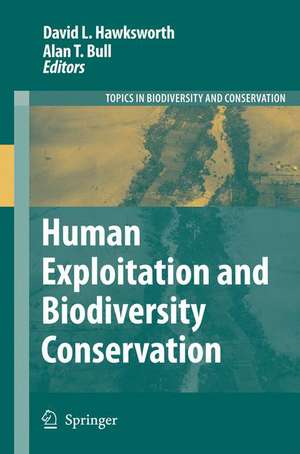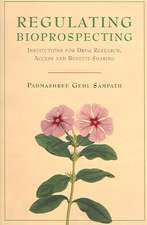Human Exploitation and Biodiversity Conservation: Topics in Biodiversity and Conservation, cartea 3
Editat de David L. Hawksworth, Alan T. Bullen Limba Engleză Hardback – 7 noi 2006
| Toate formatele și edițiile | Preț | Express |
|---|---|---|
| Paperback (1) | 1227.36 lei 6-8 săpt. | |
| SPRINGER NETHERLANDS – 22 noi 2010 | 1227.36 lei 6-8 săpt. | |
| Hardback (1) | 1236.38 lei 6-8 săpt. | |
| SPRINGER NETHERLANDS – 7 noi 2006 | 1236.38 lei 6-8 săpt. |
Din seria Topics in Biodiversity and Conservation
- 24%
 Preț: 1605.60 lei
Preț: 1605.60 lei - 18%
 Preț: 1239.49 lei
Preț: 1239.49 lei - 18%
 Preț: 947.50 lei
Preț: 947.50 lei - 18%
 Preț: 1218.21 lei
Preț: 1218.21 lei - 18%
 Preț: 942.31 lei
Preț: 942.31 lei - 18%
 Preț: 944.51 lei
Preț: 944.51 lei -
 Preț: 435.38 lei
Preț: 435.38 lei - 15%
 Preț: 646.62 lei
Preț: 646.62 lei - 24%
 Preț: 806.73 lei
Preț: 806.73 lei - 18%
 Preț: 1114.65 lei
Preț: 1114.65 lei - 18%
 Preț: 1126.35 lei
Preț: 1126.35 lei - 18%
 Preț: 1834.27 lei
Preț: 1834.27 lei - 18%
 Preț: 1019.49 lei
Preț: 1019.49 lei - 18%
 Preț: 1231.47 lei
Preț: 1231.47 lei - 18%
 Preț: 1236.38 lei
Preț: 1236.38 lei - 18%
 Preț: 1230.66 lei
Preț: 1230.66 lei - 18%
 Preț: 1232.71 lei
Preț: 1232.71 lei - 18%
 Preț: 1376.53 lei
Preț: 1376.53 lei - 18%
 Preț: 944.51 lei
Preț: 944.51 lei
Preț: 1236.38 lei
Preț vechi: 1507.77 lei
-18% Nou
Puncte Express: 1855
Preț estimativ în valută:
236.58€ • 247.67$ • 195.75£
236.58€ • 247.67$ • 195.75£
Carte tipărită la comandă
Livrare economică 05-19 aprilie
Preluare comenzi: 021 569.72.76
Specificații
ISBN-13: 9781402052828
ISBN-10: 1402052820
Pagini: 512
Ilustrații: VI, 514 p.
Dimensiuni: 155 x 235 x 25 mm
Greutate: 0.98 kg
Ediția:2006
Editura: SPRINGER NETHERLANDS
Colecția Springer
Seria Topics in Biodiversity and Conservation
Locul publicării:Dordrecht, Netherlands
ISBN-10: 1402052820
Pagini: 512
Ilustrații: VI, 514 p.
Dimensiuni: 155 x 235 x 25 mm
Greutate: 0.98 kg
Ediția:2006
Editura: SPRINGER NETHERLANDS
Colecția Springer
Seria Topics in Biodiversity and Conservation
Locul publicării:Dordrecht, Netherlands
Public țintă
ResearchCuprins
Impacts of demographic and socioeconomic factors on spatio-temporal dynamics of panda habitat.- Avian species richness and numbers in the built environment: can new housing developments be good for birds?.- Indigenous knowledge and traditional conservation of fonio millet (Digitaria exilis, Digitaria iburua) in Togo.- People and mammals in Mexico: conservation conflicts at a national scale.- Urban domestic gardens (VI): environmental correlates of invertebrate species richness.- Biodiversity conservation in sacred groves of Manipur, northeast India: population structure and regeneration status of woody species.- A numeric index to establish conservation priorities for medicinal plants in the Paravachasca Valley, Córdoba, Argentina.- Subsistence hunting and conservation issues in the game reserve of Gile, Mozambique.- The catch and trade of seahorses in Vietnam.- Urban domestic gardens (VIII): environmental correlates of invertebrate abundance.- Effects of livestock grazing on aboveground insect communities in semi-arid grasslands of southeastern Arizona.- Medicinal plants of the Argentine Yungas plants of the Las Yungas biosphere reserve, Northwest of Argentina, used in health care.- Hedges and green lanes: vegetation composition and structure.- Biodiversity and land use change on the Causse Méjan, France.- Impact of game hunting by the Kayapó of south-eastern Amazonia: implications for wildlife conservation in tropical forest indigenous reserves.- Genetic diversity in traditional Ethiopian highland maize accessions assessed by AFLP markers and morphological traits.- Towards a definition of a crop wild relative.- Household differentiation and on-farm conservation of biodiversity by indigenous households in Xishuangbanna, China.- Conservation and documentation of themedicinal plant resources of India.- Wildlife in the life of local people of the semi-arid Argentine Chaco.- An ethnobiological assessment of Rumohra adiantiformis (samambaia-preta) extractivism in Southern Brazil.- Urban areas and isolated remnants of natural habitats: an action proposal for botanical gardens.- Impacts of community-based conservation on local communities in the Annapurna Conservation Area, Nepal.- Stakeholder analysis of river restoration activity for eight years in a river channel.- Resolving the conflicts between biodiversity conservation and socioeconomic development in China: fuzzy clustering approach.- The importance of stakeholder engagement in invasive species management: a cross-jurisdictional perspective in Ireland.
Recenzii
From the reviews:
"This absorbing volume brings together papers from … the journal Biodiversity and Conservation. … Each chapter … is a little treasure house of biotic data, indigenous knowledge, or informed ideas about planning and implementing conservation projects. Overall, the collection is … manageably grand in scope. … The book is recommended as a useful addition to the library of conservation biologists, natural resource managers, grass-roots stakeholders and advocates, and, especially, students looking for a convenient entrée into the literature about global studies." (Gary Haynes, Ecology, Vol. 89 (6), 2008)
"This absorbing volume brings together papers from … the journal Biodiversity and Conservation. … Each chapter … is a little treasure house of biotic data, indigenous knowledge, or informed ideas about planning and implementing conservation projects. Overall, the collection is … manageably grand in scope. … The book is recommended as a useful addition to the library of conservation biologists, natural resource managers, grass-roots stakeholders and advocates, and, especially, students looking for a convenient entrée into the literature about global studies." (Gary Haynes, Ecology, Vol. 89 (6), 2008)
Textul de pe ultima copertă
The sustainable use of biodiversity is one of the three key objectives of the 1992 "Convention on Biological Diversity". To achieve this, sound conservation practice has to be recognized as beneficial and implemented by all who access, or use it – from subsistence farmers to skiers and pharmaceutical bioprospectors. At the same time, indigenous peoples necessarily utilize enormous numbers of plants, fungi, and fish, particularly for foods and medicines.
This book gathers together a wide range of contributions addressing diverse aspects of front-line human involvement in biodiversity exploitation and conservation. Its scope is broad, the organisms explored ranging from birds, invertebrates and mammals – both terrestrial and aquatic – to crops and medicinal plants. Meanwhile, the issues addressed include land use changes, the importance of gardens, hedges and green lanes, housing developments, hunting, invasive species, local community involvement, sacred groves, socioeconomic factors and trade.
These peer reviewed case studies come from studies in 17 countries in Africa, Asia, Europe, and North and South America. Providing a snap-shot of on-going action and state-of-the-art research, rather than a series of necessarily more superficial overviews, this collection will be of particular interest to courses including biodiversity and/or conservation issues, and to advanced students and researchers working in related fields.
Reprinted from Biodiversity and Conservation 15:8 (2006).
This book gathers together a wide range of contributions addressing diverse aspects of front-line human involvement in biodiversity exploitation and conservation. Its scope is broad, the organisms explored ranging from birds, invertebrates and mammals – both terrestrial and aquatic – to crops and medicinal plants. Meanwhile, the issues addressed include land use changes, the importance of gardens, hedges and green lanes, housing developments, hunting, invasive species, local community involvement, sacred groves, socioeconomic factors and trade.
These peer reviewed case studies come from studies in 17 countries in Africa, Asia, Europe, and North and South America. Providing a snap-shot of on-going action and state-of-the-art research, rather than a series of necessarily more superficial overviews, this collection will be of particular interest to courses including biodiversity and/or conservation issues, and to advanced students and researchers working in related fields.
Reprinted from Biodiversity and Conservation 15:8 (2006).
Caracteristici
Draws together a wide range of peer-reviewed primary research papers from biodiversity researchers around the world Provides examples from a wide spectrum of issues representing the current state-of-the art in arthropods Provides examples of recent work, usable as case studies for courses in ecology, restoration, biodiversity, conservation Enables specialist researchers to see primary research papers tackling problems in arthropods






